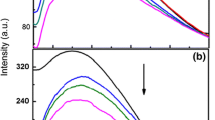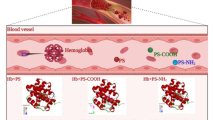Abstract
Recently, the great interests in application of natural product have led to focus on the potential impact on bio macromolecules. Propolis is one of the natural products with various biological activities such as anti-diabetic effect. Under hyperglycemia, hemoglobin (Hb) frequently undergoes non-enzymatic glycation which affect its structure and function. In this study, the binding interaction between bulk propolis and three forms of Hb, native Hb, glycated Hb (GHb) and fructated Hb (FHb), in two temperatures of 25 and 37 °C have been examined and compared with our previous study (interaction of propolis nanoparticles with Hb, GHb and FHb). The binding studied with applying fluorescence and far UV circular dichroism spectroscopic techniques. Bulk Propolis possess the ability to quench the intrinsic fluorescence of the different types Hb like propolis nanoparticles. The mechanism of interaction bulk propolis with different types Hb was similar to the propolis nanoparticles, dynamic quenching in native Hb and static quenching in glycated and fructated Hb. According to the modified Stern–Volmer equation, the binding constant and number of binding sites were obtained. The result suggested that propolis nanoparticles have more quenching rate constant (kq) in compared to the bulk propolis in interaction different types Hb. In addition, the values of binding constant (Kb) revealed that nanopropolis has more binding affinity in compared to the bulk propolis. Data obtained from thermodynamic parameters implied more portion of electrostatic forces in GHb-propolis than native Hb-propolis and more hydrophobic portion in FHb-propolis. The CD spectra of Hb, GHb and FHb displayed no significant changes in secondary structure after incubated with propolis. These data are agreement with propolis nanoparticles. Results showed that propolis nanoparticles are a stronger quencher and bound to Hb, GHb and FHb with higher affinity than bulk propolis.




Similar content being viewed by others
References
Abd El Megid AD, Khaled M, Emam MA, Adel A (2018) Biochemical role of zinc oxide and propolis nanoparticles in protection rabbits against coccidiosis. Benha Veterinary Medical Journal 34(1):314–328
Ahmed N, Thornalley PJ (2007) Advanced glycation endproducts: what is their relevance to diabetic complications? Diabetes Obes Metab 9(3):233–245
Ahmed N (2005) Advanced glycation endproducts—role in pathology of diabetic complications. Diabetes Res Clin Pract 67(1):3–21
Ahn MR, Kumazawa S, Usui Y, Nakamura J, Matsuka M, Zhu F, Nakayama T (2007) Antioxidant activity and constituents of propolis collected in various areas of China. Food Chem 101(4):1383–1392
Anjum SI, Ullah A, Khan KA, Attaullah M, Khan H, Ali H, Bashir MA, Tahir M, Ansari MJ, Ghramh HA, Adgaba N (2019) Composition and functional properties of propolis (bee glue): A review. Saudi Journal of Biological Sciences 26(7):1695–1703
Ayodhya D, Veerabhadram G (2016) Green synthesis, optical, structural, photocatalytic, fluorescence quenching and degradation studies of ZnS nanoparticles. J Fluoresc 26(6):2165–2175
Bose T, Bhattacherjee A, Banerjee S, Chakraborti AS (2013) Methylglyoxal-induced modifications of hemoglobin: structural and functional characteristics. Arch Biochem Biophys 529(2):99–104
Bose T, Chakraborti AS (2008) Fructose-induced structural and functional modifications of hemoglobin: implication for oxidative stress in diabetes mellitus. Biochimica et Biophysica Acta (BBA)-General Subjects1780(5):800–8.
Chakraborty S, Chaudhuri S, Pahari B, Taylor J, Sengupta PK, Sengupta B (2012) A critical study on the interactions of hesperitin with human hemoglobin: Fluorescence spectroscopic and molecular modeling approach. J Lumin 132(6):1522–1528
Cho N, Shaw JE, Karuranga S, Huang Y, da Rocha Fernandes JD, Ohlrogge AW, Malanda B (2013) IDF Diabetes Atlas: Global estimates of diabetes prevalence for 2017 and projections for 2045. Diabetes Res Clin Pract 138:271–281
Corrêa DH, Ramos CH (2009) The use of circular dichroism spectroscopy to study protein folding, form and function. Afr J Biochem Res 3(5):164–173
Darshan TR (2012) An overview of propolis as potential of new drug development. Journal of Pharmacy Education and Research 3(2):113–119
Esfandfar P, Falahati M, Saboury A (2016) Spectroscopic studies of interaction between CuO nanoparticles and bovine serum albumin. J Biomol Struct Dyn 34(9):1962–1968
GhoshMoulick R, Bhattacharya J, Roy S, Basak S, Dasgupta AK (2007) Compensatory secondary structure alterations in protein glycation. Biochimica et Biophysica Acta (BBA)-Proteins and Proteomics 1774(2):233–42.
Goodarzi M, Moosavi-Movahedi AA, Habibi-Rezaei M, Shourian M, Ghourchian H, Ahmad F, Farhadi M, Saboury AA, Sheibani N (2014) Hemoglobin fructation promotes heme degradation through the generation of endogenous reactive oxygen species. Spectrochim Acta Part A Mol Biomol Spectrosc 130:561–567
Guariguata L, Whiting DR, Hambleton I, Beagley J, Linnenkamp U, Shaw JE (2014) Global estimates of diabetes prevalence for 2013 and projections for 2035. Diabetes Res Clin Pract 103(2):137–149
Gugliucci A (2017) Formation of fructose-mediated advanced glycation end products and their roles in metabolic and inflammatory diseases. Advances in nutrition 8(1):54–62
Jianrong C, Yuqing M, Nongyue H, Xiaohua W, Sijiao L (2004) Nanotechnology and biosensors. Biotechnol Adv 22(7):505–518
Kar M, Roy A, Bose T, Chakraborti AS (2006) Effect of glycation of hemoglobin on its interaction with trifluoperazine. Protein J 25(3):202–211
Kazemi F, Divsalar A, Saboury AA (2018) Structural analysis of the interaction between free, glycated and fructated hemoglobin with propolis nanoparticles: A spectroscopic study. Int J Biol Macromol 109:1329–1337
Koohshekan B, Divsalar A (2017) In vitro glycation of bovine liver catalase by glucose and fructose and antigycation effects of aspirin: a spectroscopic study. J Biomol Struct Dyn 35(14):3061–3069
Mahmoudi M, Lynch I, Ejtehadi MR, Monopoli MP, Bombelli FB, Laurent S (2011) Protein− nanoparticle interactions: opportunities and challenges. Chem Rev 111(9):5610–5637
Maji A, Beg M, Mandal AK, Das S, Jha PK, Kumar A, Sarwar S, Hossain M, Chakrabarti P (2017) Spectroscopic interaction study of human serum albumin and human hemoglobin with Mersilea quadrifolia leaves extract mediated silver nanoparticles having antibacterial and anticancer activity. J Mol Struct 1141:584–592
Naeeminejad S, Assaran Darban R, Beigoli S, Saberi MR, Chamani J (2017) Studying the interaction between three synthesized heterocyclic sulfonamide compounds with hemoglobin by spectroscopy and molecular modeling techniques. J Biomol Struct Dyn 35(15):3250–3267
Naveenraj S, Anandan S (2013) Binding of serum albumins with bioactive substances–nanoparticles to drugs. J Photochem Photobiol, C 14:53–71
Nna VU, Bakar AB, Lazin MR, Mohamed M (2018) Antioxidant, anti-inflammatory and synergistic anti-hyperglycemic effects of Malaysian propolis and metformin in streptozotocin–induced diabetic rats. Food Chem Toxicol 120:305–320
Ojha B, Das G (2010) The interaction of 5-(alkoxy) naphthalen-1-amine with bovine serum albumin and its effect on the conformation of protein. J Phys Chem B 114(11):3979–3986
Rashidipour S, Naeeminejad S, Chamani J (2016) Study of the interaction between DNP and DIDS with human hemoglobin as binary and ternary systems: spectroscopic and molecular modeling investigation. J Biomol Struct Dyn 34(1):57–77
Ross PD, Subramanian S (1981) Thermodynamics of protein association reactions: forces contributing to stability. Biochemistry 20(11):3096–3102
Roy S, Das TK (2015) Study of interaction between tryptophan, tyrosine, and phenylalanine separately with silver nanoparticles by fluorescence quenching method. J Appl Spectrosc 82(4):598–606
Sahebi U, Divsalar A (2016) Synergistic and inhibitory effects of propolis and aspirin on structural changes of human hemoglobin resulting from glycation: an in vitro study. J Iran Chem Soc 13(11):2001–2011
Sarzehi S, Chamani J (2010) Investigation on the interaction between tamoxifen and human holo-transferrin: determination of the binding mechanism by fluorescence quenching, resonance light scattering and circular dichroism methods. Int J Biol Macromol 47(4):558–569
Sen S, Bose T, Roy A, Chakraborti AS (2007) Effect of non-enzymatic glycation on esterase activities of hemoglobin and myoglobin. Mol Cell Biochem 301(1–2):251–257
Sen S, Kar M, Roy A, Chakraborti AS (2005) Effect of nonenzymatic glycation on functional and structural properties of hemoglobin. Biophys Chem 113(3):289–298
Sengupta B, Swenson J (2005) Properties of normal and glycated human hemoglobin in presence and absence of antioxidant. Biochem Biophys Res Commun 334(3):954–959
Sforcin JM, Bankova V (2011) Propolis: is there a potential for the development of new drugs? J Ethnopharmacol 133(2):253–260
Shibata T, Shibata S, Shibata N, Kiyokawa E, Sasaki H, Singh DP, Kubo E (2016) Propolis, a Constituent of Honey, Inhibits the Development of Sugar Cataracts and High-Glucose-Induced Reactive Oxygen Species in Rat Lenses. Journal of ophthalmology 2016:1–6
Shao Q, Wu P, Gu P, Xu X, Zhang H, Cai C (2011) Electrochemical and spectroscopic studies on the conformational structure of hemoglobin assembled on gold nanoparticles. J Phys Chem B 115(26):8627–8637
Siddiqui Z, Ishtikhar M, Ahmad S (2018) d-Ribose induced glycoxidative insult to hemoglobin protein: An approach to spot its structural perturbations. Int J Biol Macromol 112:134–147
Sreedhanya S, Jeena VR, Ammu S, Aravindakumar CT, Aravind UK (2020) Spectroscopic and theoretical methods to probe protein–ligand binding. Materials Today: Proceedings 1–6.
Sun Y, Wei S, Yin C, Liu L, Hu C, Zhao Y, Ye Y, Hu X, Fan J (2011) Synthesis and spectroscopic characterization of 4-butoxyethoxy-N-octadecyl-1, 8-naphthalimide as a new fluorescent probe for the determination of proteins. Bioorg Med Chem Lett 21(12):3798–3804
Vasan S, Foiles P, Founds H (2003) Therapeutic potential of breakers of advanced glycation end product–protein crosslinks. Arch Biochem Biophys 419(1):89–96
Wang C, Liu B, Bian G, Ma L (2017) Investigation on the interaction of glipizide with bovine hemoglobin by spectroscopy and molecular docking. Spectroscopy Letter 50(9):476–481
Zeinabad HA, Kachooei E, Saboury AA, Kostova I, Attar F, Vaezzadeh M, Falahati M (2016) Thermodynamic and conformational changes of protein toward interaction with nanoparticles: a spectroscopic overview. RSC advances 6(107):105903–105919
Zolghadri S, Saboury AA, Golestani A, Divsalar A, Rezaei-Zarchi S, Moosavi-Movahedi AA (2009) Interaction between silver nanoparticle and bovine hemoglobin at different temperatures. J Nanopart Res 11(7):1751
Acknowledgements
The authors would like to thank the respectful Research Council of Kharazmi University (Grant No. 1397) for their financial support.
Author information
Authors and Affiliations
Corresponding author
Ethics declarations
Conflict of interest
The authors strictly state that the content of this paper has no conflict of interest.
Rights and permissions
About this article
Cite this article
Kazemi, F., Divsalar, A. & Saboury, A.A. Binding Interaction of Glycated, Fructated and Native Human Hemoglobin with Bulk Propolis. Iran J Sci Technol Trans Sci 45, 785–793 (2021). https://doi.org/10.1007/s40995-021-01108-1
Received:
Accepted:
Published:
Issue Date:
DOI: https://doi.org/10.1007/s40995-021-01108-1




